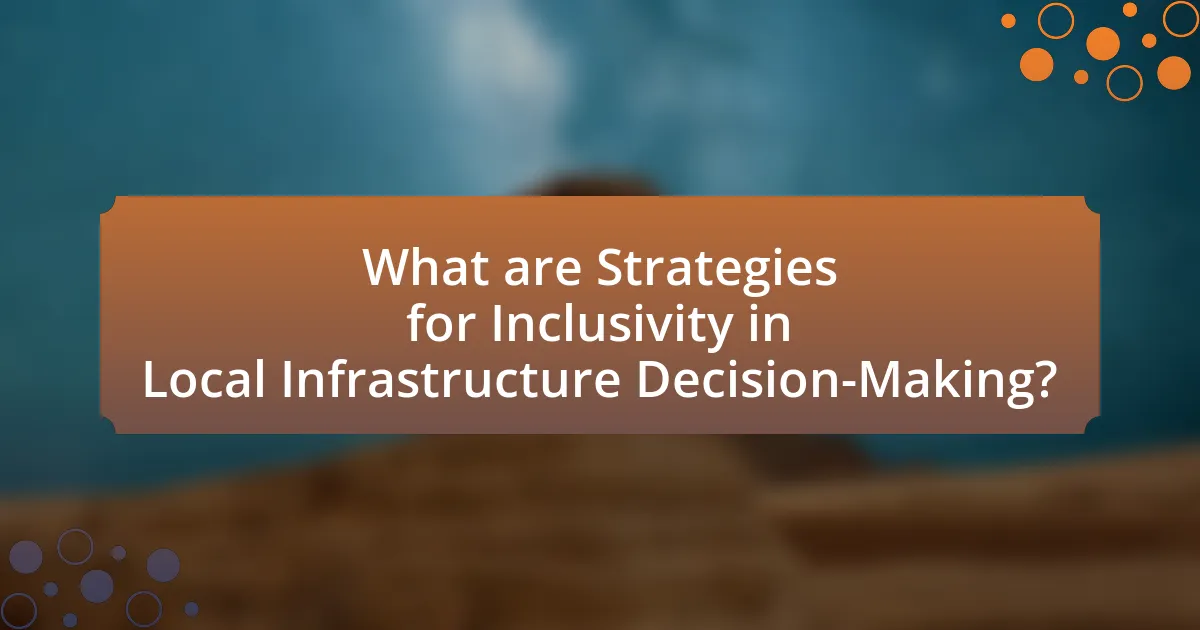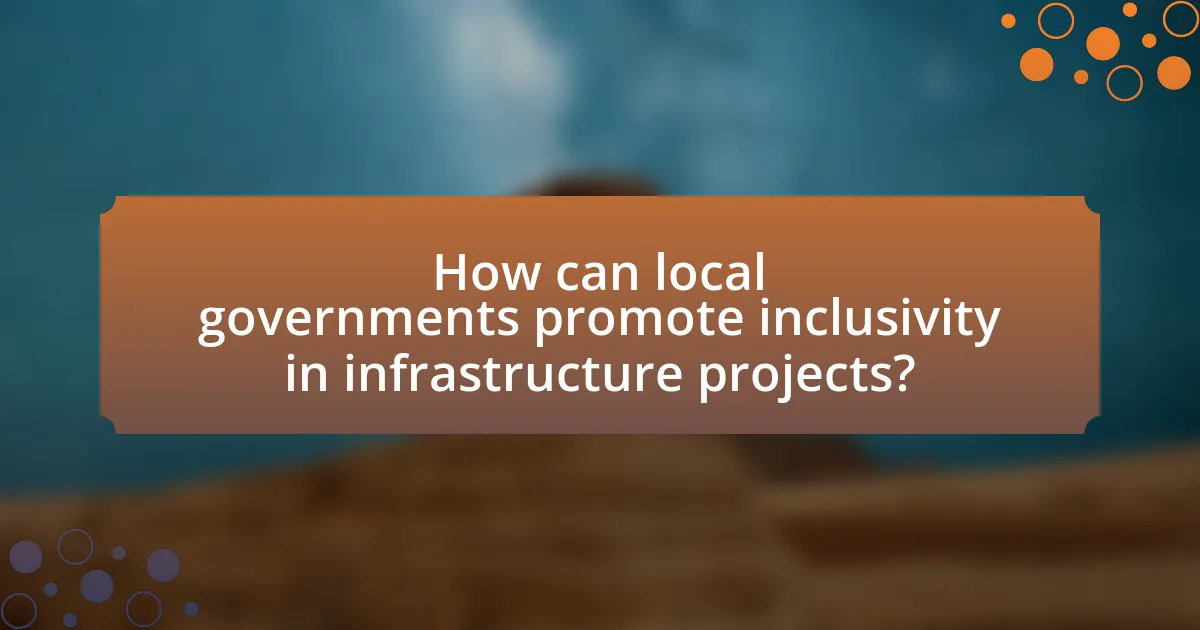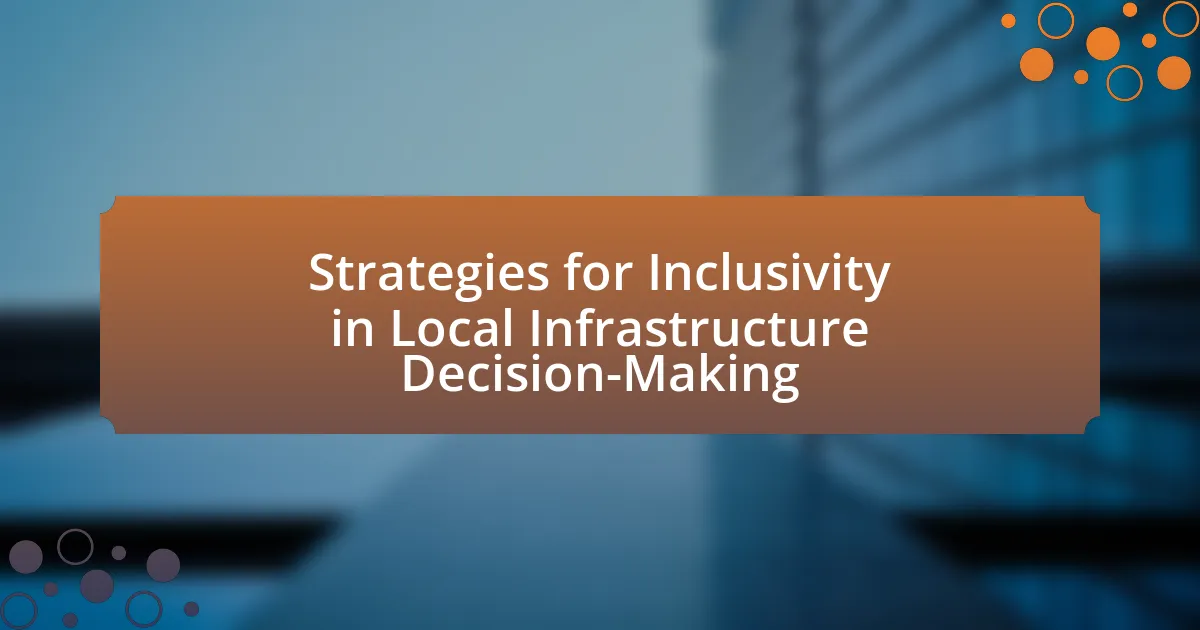The article focuses on strategies for inclusivity in local infrastructure decision-making, emphasizing the importance of engaging diverse community stakeholders, utilizing participatory budgeting, and ensuring transparent communication. It outlines the significance of inclusivity in addressing the needs of marginalized groups, enhancing community trust, and improving project outcomes. The article also discusses the potential consequences of excluding certain demographics, the role of community representation, and the challenges faced in implementing inclusive strategies. Additionally, it highlights best practices, effective methods for gathering community input, and the benefits of cross-sector partnerships in fostering equitable infrastructure development.

What are Strategies for Inclusivity in Local Infrastructure Decision-Making?
Strategies for inclusivity in local infrastructure decision-making include engaging diverse community stakeholders, utilizing participatory budgeting, and implementing transparent communication channels. Engaging diverse community stakeholders ensures that voices from various demographics, including marginalized groups, are heard and considered in the planning process. Participatory budgeting allows community members to have a direct say in how funds are allocated, fostering a sense of ownership and accountability. Transparent communication channels, such as public forums and online platforms, facilitate ongoing dialogue between decision-makers and the community, ensuring that feedback is integrated into infrastructure projects. These strategies have been shown to enhance community trust and improve project outcomes, as evidenced by case studies in cities like Seattle and Barcelona, where inclusive practices led to more equitable infrastructure development.
Why is inclusivity important in local infrastructure decision-making?
Inclusivity is important in local infrastructure decision-making because it ensures that the needs and perspectives of all community members are considered, leading to more equitable and effective outcomes. When diverse voices are included, infrastructure projects are more likely to address the specific requirements of various groups, such as marginalized populations, thereby reducing disparities in access to services and resources. Research indicates that inclusive decision-making processes can enhance community trust and engagement, ultimately resulting in higher satisfaction with public services and infrastructure. For example, a study by the National Cooperative Highway Research Program found that inclusive practices in transportation planning lead to better project outcomes and increased public support.
What are the potential consequences of excluding certain groups?
Excluding certain groups can lead to significant social, economic, and political consequences. Socially, it can foster feelings of alienation and resentment among marginalized communities, which may result in increased tensions and conflict. Economically, exclusion can limit access to resources and opportunities, leading to disparities in wealth and employment, as evidenced by studies showing that inclusive policies can enhance economic growth by up to 30%. Politically, the exclusion of specific groups can undermine democratic processes, as seen in cases where disenfranchised populations have lower voter turnout, ultimately skewing representation and policy outcomes. These consequences highlight the importance of inclusivity in local infrastructure decision-making to ensure equitable development and social cohesion.
How does inclusivity enhance community engagement?
Inclusivity enhances community engagement by ensuring that diverse voices and perspectives are represented in decision-making processes. When all community members, regardless of background, are included, it fosters a sense of belonging and ownership, which increases participation rates in community initiatives. Research indicates that inclusive practices lead to higher levels of trust and collaboration among community members, as seen in the 2018 study by the National Civic League, which found that communities with inclusive engagement strategies reported a 30% increase in civic participation. This demonstrates that inclusivity not only enriches the decision-making process but also strengthens community bonds and encourages active involvement.
What key principles guide inclusive decision-making?
Key principles that guide inclusive decision-making include representation, transparency, and collaboration. Representation ensures that diverse voices and perspectives are included in the decision-making process, which is essential for addressing the needs of all community members. Transparency involves openly sharing information and processes, allowing stakeholders to understand how decisions are made and fostering trust. Collaboration emphasizes the importance of working together across different sectors and communities to create solutions that reflect collective input. These principles are supported by research indicating that inclusive decision-making leads to better outcomes and increased community satisfaction, as seen in studies conducted by the International Association for Public Participation, which highlight the positive impact of stakeholder engagement on project success.
How can transparency be achieved in the decision-making process?
Transparency in the decision-making process can be achieved by implementing clear communication channels and providing accessible information to all stakeholders. Establishing regular updates, public forums, and detailed documentation of decisions fosters an environment where stakeholders can understand the rationale behind choices made. Research indicates that communities with open data initiatives, such as the City of Boston’s Open Data program, report higher levels of public trust and engagement, demonstrating that transparency leads to more informed and inclusive decision-making.
What role does community representation play in inclusivity?
Community representation is essential for fostering inclusivity as it ensures that diverse voices and perspectives are integrated into decision-making processes. When communities are represented, their unique needs and concerns are acknowledged, leading to more equitable outcomes in local infrastructure projects. Research indicates that inclusive decision-making can enhance community trust and engagement, as seen in studies like “The Role of Community Engagement in Infrastructure Planning” by the Urban Institute, which highlights that projects with active community involvement are more likely to meet the actual needs of residents. Thus, community representation not only promotes fairness but also improves the effectiveness of local infrastructure initiatives.
What are the challenges to implementing inclusive strategies?
The challenges to implementing inclusive strategies include resistance to change, lack of resources, and insufficient stakeholder engagement. Resistance to change often stems from established practices and mindsets that prioritize traditional decision-making processes over inclusive approaches. Lack of resources, both financial and human, can hinder the development and execution of inclusive strategies, as organizations may struggle to allocate necessary funding or personnel. Insufficient stakeholder engagement can lead to a disconnect between decision-makers and the communities they serve, resulting in strategies that do not adequately address the needs of all groups. These challenges are supported by research indicating that successful inclusivity requires overcoming entrenched barriers and fostering collaboration among diverse stakeholders.
What barriers do marginalized communities face in infrastructure decisions?
Marginalized communities face significant barriers in infrastructure decisions, primarily due to systemic inequities, lack of representation, and limited access to resources. Systemic inequities manifest in the form of historical disinvestment in these communities, leading to inadequate infrastructure and services. Lack of representation occurs when decision-making bodies do not include voices from marginalized groups, resulting in policies that do not reflect their needs. Limited access to resources, including financial, informational, and technical support, further hinders these communities from effectively participating in infrastructure planning and decision-making processes. For instance, a report by the National Association of Counties highlights that communities of color often experience a lack of investment in public infrastructure, which exacerbates existing disparities.
How can resistance to change be addressed?
Resistance to change can be addressed by actively involving stakeholders in the decision-making process. Engaging community members and stakeholders fosters a sense of ownership and reduces apprehension towards new initiatives. Research indicates that participatory approaches, such as public consultations and workshops, enhance transparency and trust, leading to greater acceptance of changes. For instance, a study by the International Association for Public Participation found that projects with high stakeholder engagement had a 70% higher success rate in implementation compared to those with minimal involvement.

How can local governments promote inclusivity in infrastructure projects?
Local governments can promote inclusivity in infrastructure projects by actively engaging diverse community stakeholders throughout the planning and implementation phases. This engagement can include public forums, surveys, and workshops that specifically target underrepresented groups, ensuring their voices and needs are considered. Research indicates that inclusive decision-making leads to more equitable outcomes; for instance, a study by the Urban Institute found that projects with community involvement are 30% more likely to meet the needs of marginalized populations. By prioritizing transparency and collaboration, local governments can create infrastructure that serves all community members effectively.
What methods can be used to gather community input?
Surveys and questionnaires are effective methods to gather community input. These tools allow for the collection of quantitative and qualitative data from a broad audience, enabling stakeholders to understand community needs and preferences. According to a study by the International Association for Public Participation, surveys can reach a diverse demographic, ensuring that various voices are heard in decision-making processes. Additionally, public meetings and focus groups facilitate direct interaction, allowing community members to express their opinions and engage in discussions, which fosters a sense of ownership and collaboration in local infrastructure projects.
How can surveys and public forums be effectively utilized?
Surveys and public forums can be effectively utilized by ensuring they are designed to gather diverse community input and facilitate open dialogue. Effective surveys should include clear, concise questions that allow for quantitative and qualitative data collection, enabling stakeholders to understand community needs and preferences. Public forums should be structured to encourage participation from all demographics, utilizing strategies such as targeted outreach and accessible venues. Research indicates that inclusive engagement processes lead to better decision-making outcomes, as seen in the National Cooperative Highway Research Program’s report on public involvement, which highlights that communities with diverse input experience higher satisfaction with infrastructure projects.
What role do social media and technology play in outreach?
Social media and technology serve as critical tools for outreach by enhancing communication, engagement, and information dissemination. They enable organizations to reach diverse audiences quickly and effectively, facilitating real-time interaction and feedback. For instance, platforms like Facebook and Twitter allow for targeted messaging, which can increase participation in local infrastructure decision-making processes. According to a 2020 Pew Research Center study, 69% of adults in the U.S. use social media, highlighting its potential to engage a broad demographic. Additionally, technology such as mobile apps and online surveys can gather community input efficiently, ensuring that diverse voices are included in decision-making.
What partnerships can enhance inclusivity efforts?
Collaborations between local governments, community organizations, and businesses can significantly enhance inclusivity efforts. These partnerships enable diverse stakeholder engagement, ensuring that the voices of marginalized groups are heard in infrastructure decision-making processes. For instance, the National League of Cities emphasizes that inclusive partnerships can lead to more equitable resource allocation and improved community outcomes. By leveraging the strengths of each partner, such as local knowledge from community organizations and funding from businesses, these collaborations can create more accessible and representative infrastructure projects.
How can collaboration with local organizations improve outreach?
Collaboration with local organizations can significantly improve outreach by leveraging their established networks and community trust. Local organizations often have deep-rooted connections within the community, which facilitates the dissemination of information and resources more effectively than external entities. For instance, a study by the Urban Institute found that partnerships with local nonprofits increased community engagement in infrastructure projects by 40%, demonstrating that local organizations can mobilize residents and enhance participation. This collaboration not only amplifies outreach efforts but also ensures that the initiatives are more aligned with the community’s needs and values, leading to more successful outcomes in local infrastructure decision-making.
What benefits do cross-sector partnerships provide?
Cross-sector partnerships provide enhanced resource sharing, innovation, and improved problem-solving capabilities. These collaborations leverage the unique strengths and expertise of different sectors, such as public, private, and non-profit, to address complex social issues more effectively. For instance, a study by the Stanford Social Innovation Review highlights that cross-sector partnerships can lead to more sustainable solutions by combining financial resources from the private sector with the social mission of non-profits, resulting in greater impact on community development.
What best practices should be followed for inclusive decision-making?
Best practices for inclusive decision-making include actively engaging diverse stakeholders, ensuring representation from marginalized groups, and fostering open communication. Engaging diverse stakeholders allows for a variety of perspectives, which enhances the quality of decisions. Representation from marginalized groups is crucial, as it ensures that the needs and concerns of all community members are considered. Open communication creates an environment where all voices can be heard, leading to more equitable outcomes. Research by the International Association for Public Participation highlights that inclusive processes lead to better decision-making and increased public trust in local governance.
How can ongoing education and training for decision-makers be implemented?
Ongoing education and training for decision-makers can be implemented through structured programs that incorporate workshops, online courses, and mentorship opportunities. These programs should focus on relevant topics such as community engagement, equity in decision-making, and sustainable practices. For instance, the National League of Cities offers resources and training modules specifically designed for local leaders to enhance their skills in inclusive governance. Additionally, integrating real-world case studies and interactive simulations can provide practical experience, reinforcing the learning process. Research indicates that continuous professional development leads to improved decision-making outcomes, as seen in studies conducted by the International City/County Management Association, which highlight the positive impact of training on local governance effectiveness.
What frameworks can be established to ensure accountability?
To ensure accountability in local infrastructure decision-making, frameworks such as participatory governance, transparency mechanisms, and performance evaluation systems can be established. Participatory governance involves engaging community members in the decision-making process, which fosters ownership and responsibility. Transparency mechanisms, such as public reporting and open data initiatives, allow stakeholders to access information about decisions and expenditures, thereby holding decision-makers accountable. Performance evaluation systems assess the effectiveness of projects and policies, ensuring that they meet community needs and objectives. These frameworks collectively enhance accountability by promoting stakeholder involvement, ensuring access to information, and evaluating outcomes against established goals.

What are the outcomes of successful inclusive decision-making?
Successful inclusive decision-making leads to enhanced community engagement and improved project outcomes. When diverse perspectives are integrated into the decision-making process, it fosters a sense of ownership among stakeholders, resulting in higher satisfaction and support for initiatives. Research indicates that inclusive practices can increase the effectiveness of local infrastructure projects by ensuring that the needs and preferences of all community members are considered, ultimately leading to more sustainable and equitable solutions. For example, a study by the National Cooperative Highway Research Program found that projects involving stakeholder input were 30% more likely to meet community needs effectively.
How does inclusivity impact the quality of infrastructure projects?
Inclusivity significantly enhances the quality of infrastructure projects by ensuring that diverse community needs and perspectives are considered during the planning and execution phases. When stakeholders from various backgrounds, including marginalized groups, are involved, projects are more likely to address specific local challenges and preferences, leading to better functionality and user satisfaction. Research indicates that inclusive decision-making processes can improve project outcomes; for instance, a study by the National Cooperative Highway Research Program found that projects incorporating community input resulted in a 20% increase in public approval ratings. This demonstrates that inclusivity not only fosters a sense of ownership among community members but also leads to more effective and sustainable infrastructure solutions.
What evidence supports the benefits of inclusive practices?
Evidence supporting the benefits of inclusive practices includes improved decision-making outcomes and enhanced community engagement. Research conducted by the National League of Cities indicates that inclusive practices lead to more representative decision-making, resulting in policies that better reflect the needs of diverse populations. Additionally, a study published in the Journal of Urban Affairs found that inclusive community engagement processes increase public trust and satisfaction with local governance, demonstrating that when diverse voices are included, the effectiveness of infrastructure projects is significantly enhanced.
How can success be measured in inclusive decision-making?
Success in inclusive decision-making can be measured by the extent to which diverse stakeholder perspectives are integrated into the final decisions. This can be quantified through metrics such as the representation of marginalized groups in decision-making processes, the number of stakeholder consultations conducted, and the degree of satisfaction among participants regarding their involvement. For instance, a study by the International Association for Public Participation found that projects with higher stakeholder engagement reported a 30% increase in community satisfaction and trust in local governance. These metrics provide concrete evidence of the effectiveness of inclusive practices in decision-making.
What lessons can be learned from successful case studies?
Successful case studies in local infrastructure decision-making demonstrate the importance of stakeholder engagement, data-driven decision-making, and adaptability. Stakeholder engagement ensures that diverse community voices are heard, leading to more equitable outcomes. For instance, the case study of the San Francisco Bay Area’s transportation planning involved extensive public consultations, resulting in projects that better reflect community needs. Data-driven decision-making, as seen in the Chicago Transit Authority’s initiatives, utilizes analytics to prioritize projects based on actual usage patterns, enhancing resource allocation. Lastly, adaptability is crucial; the New York City resilience planning case illustrates how flexible strategies can respond to changing community dynamics and environmental challenges, ensuring long-term sustainability. These lessons highlight effective practices that can be replicated to foster inclusivity in infrastructure planning.
What strategies were effective in specific communities?
Effective strategies in specific communities for inclusivity in local infrastructure decision-making include participatory budgeting, community engagement forums, and the establishment of advisory committees. Participatory budgeting allows residents to directly influence how public funds are allocated, fostering a sense of ownership and accountability. Community engagement forums facilitate open dialogue between local government and residents, ensuring diverse voices are heard in the decision-making process. Advisory committees, composed of community members, provide ongoing input and feedback on infrastructure projects, enhancing transparency and responsiveness. These strategies have been shown to increase community satisfaction and improve project outcomes, as evidenced by case studies in cities like Porto Alegre, Brazil, where participatory budgeting led to significant improvements in public services.
How can these lessons be applied to other localities?
Lessons from strategies for inclusivity in local infrastructure decision-making can be applied to other localities by implementing community engagement practices that prioritize diverse stakeholder input. For instance, local governments can adopt participatory budgeting processes, which have been shown to increase civic participation and ensure that marginalized voices are heard, as evidenced by the success of such initiatives in cities like Porto Alegre, Brazil, where citizen involvement led to more equitable resource allocation. Additionally, utilizing data-driven approaches to assess community needs can help tailor infrastructure projects to reflect the unique demographics and challenges of different areas, as demonstrated by the use of GIS mapping in urban planning. These methods foster a more inclusive decision-making environment, ultimately leading to infrastructure that better serves all community members.
What practical steps can local governments take to enhance inclusivity?
Local governments can enhance inclusivity by implementing community engagement initiatives that actively involve diverse populations in decision-making processes. These initiatives can include public forums, surveys, and focus groups specifically designed to gather input from underrepresented communities, ensuring their voices are heard in local infrastructure planning. Research shows that inclusive decision-making leads to better outcomes; for instance, a study by the National League of Cities found that cities with strong community engagement practices experience increased trust and satisfaction among residents. By prioritizing these engagement strategies, local governments can create more equitable and representative infrastructure policies.
How can local governments create a culture of inclusivity?
Local governments can create a culture of inclusivity by actively engaging diverse community members in decision-making processes. This can be achieved through initiatives such as public forums, surveys, and workshops that specifically target underrepresented groups, ensuring their voices are heard and considered in local policies. Research indicates that inclusive decision-making leads to better outcomes; for instance, a study by the National League of Cities found that cities with inclusive practices experience increased community trust and participation, resulting in more effective governance. By implementing these strategies, local governments can foster an environment where all community members feel valued and included.
What resources are available for implementing inclusive strategies?
Resources available for implementing inclusive strategies include guidelines, toolkits, and training programs specifically designed for local infrastructure decision-making. For instance, the National Association of City Transportation Officials (NACTO) provides a toolkit that outlines best practices for inclusive public engagement in transportation planning. Additionally, the American Planning Association offers resources that focus on equitable community engagement and planning processes. Research indicates that utilizing these resources can enhance participation from diverse community members, leading to more equitable infrastructure outcomes.
